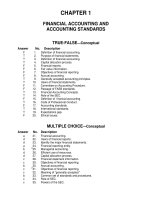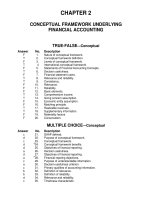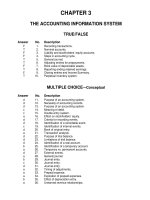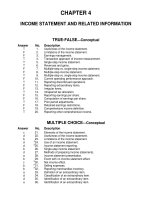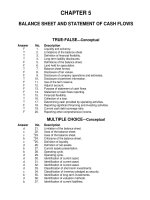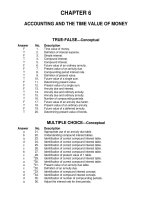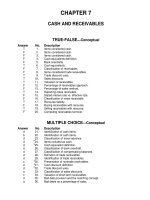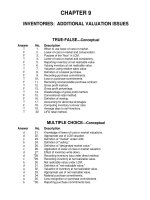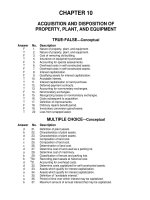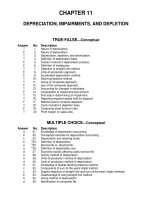Test bank with answers intermediate accounting 12e by kieso chapter 05
Bạn đang xem bản rút gọn của tài liệu. Xem và tải ngay bản đầy đủ của tài liệu tại đây (103.86 KB, 33 trang )
To download more slides, ebook, solutions and test bank, visit
CHAPTER 5
BALANCE SHEET AND STATEMENT OF CASH FLOWS
TRUE-FALSE—Conceptual
Answer
F
T
T
T
F
F
T
F
F
T
F
F
F
F
T
T
T
F
T
F
No.
Description
1.
2.
3.
4.
5.
6.
7.
8.
9.
10.
11.
12.
13.
14.
15.
16.
17.
18.
19.
20.
Liquidity and solvency.
Limitations of the balance sheet.
Definition of financial flexibility.
Long-term liability disclosures.
Definitions of the balance sheet.
Land held for speculation.
Balance sheet format.
Disclosure of fair values.
Disclosure of company operations and estimates.
Disclosure of pertinent information.
Use of the term reserve.
Adjunct account.
Purpose of statement of cash flows.
Statement of cash flows reporting.
Financial flexibility.
Collection of a loan.
Determining cash provided by operating activities.
Reporting significant financing and investing activities.
Current cash debt coverage ratio.
Reporting other comprehensive income.
MULTIPLE CHOICE—Conceptual
Answer
d
c
c
b
c
d
b
b
d
d
d
d
d
c
b
d
b
No.
21.
22.
S
23.
S
24.
P
25.
26.
27.
28.
29.
30.
31.
32.
33.
34.
35.
36.
37.
Description
Limitation of the balance sheet.
Uses of the balance sheet.
Uses of the balance sheet.
Criticisms of the balance sheet.
Definition of liquidity.
Definition of net assets.
Current assets presentation.
Operating cycle.
Operating cycle.
Identification of current asset.
Identification of current asset.
Identification of current asset.
Classification of short-term investments.
Classification of inventory pledged as security.
Identification of long-term investments.
Identification of valuation methods.
Identification of current liabilities.
To download more slides, ebook, solutions and test bank, visit
Test Bank for Intermediate Accounting, Twelfth Edition
5-2
Answer
d
b
d
d
d
d
d
c
d
d
d
d
d
d
d
b
c
c
b
b
c
a
d
b
b
d
c
b
b
P
S
No.
38.
39.
40.
41.
42.
43.
44.
45.
46.
P
47.
S
48.
49.
50.
51.
52.
53.
54.
S
55.
56.
57.
58.
59.
60.
61.
62.
63.
64.
S
65.
P
66.
Description
Definition of working capital.
Identification of working capital items.
Identification of long-term liabilities.
Identification of long-term liabilities.
Classification of treasury stock.
Disclosures for common stock.
Classification of investment in affiliate.
Classification of owners' equity.
Classification of assets.
Identification of contra account.
Balance sheet supplementary disclosure.
Methods of disclosure.
Disclosure of significant accounting policies.
Disclosure of depreciation methods used.
Required notes to the financial statements.
Identification of generally accepted account titles.
Purpose of the statement of cash flows.
Statement of cash flows answers.
Classification of cash receipts.
Identify a financing activity.
Cash flow from operating activities.
Identify an investing activity.
Preparing the statement of cash flows.
Cash debt coverage ratio.
Current cash debt coverage ratio.
Financial flexibility measure.
Calculation of free cash flow.
Description of financial flexibility.
Cash debt coverage ratio.
Note: these questions also appear in the Problem-Solving Survival Guide.
Note: these questions also appear in the Study Guide.
MULTIPLE CHOICE—Computational
Answer
c
a
b
d
a
b
b
b
c
c
a
b
a
b
No.
Description
67.
68.
69.
70.
71.
72.
73.
74.
75.
76.
77.
78.
79.
80.
Classifying investments.
Identifying intangible assets
Calculate total stockholders’ equity.
Classifying investments.
Identifying intangible assets.
Calculate total stockholders’ equity.
Calculate ending cash balance.
Calculate ending cash balance.
Cash provided by operating activities.
Cash provided by operating activities.
Cash debt coverage ratio.
Free cash flow.
Cash debt coverage ratio.
Free cash flow.
To download more slides, ebook, solutions and test bank, visit
Balance Sheet and Statement of Cash Flows
MULTIPLE CHOICE—CPA Adapted
Answer
d
d
a
c
b
c
c
a
d
b
No.
Description
81.
82.
83.
84.
85.
86.
87.
88.
89.
90.
Calculate total current assets.
Calculate total current assets.
Calculate total current liabilities.
Calculate retained earnings balance.
Calculate current and long-term liabilities.
Summary of significant accounting policies.
Classification of investing activity.
Classification of operating activity.
Classification of financing activity.
Classification of investing activity.
EXERCISES
Item
E5-91
E5-92
E5-93
E5-94
E5-95
E5-96
E5-97
E5-98
E5-99
E5-100
Description
Definitions.
Terminology.
Current assets.
Account classification.
Valuation of balance sheet items.
Balance sheet classifications.
Balance sheet classifications.
Balance sheet classifications.
Statement of cash flows.
Statement of cash flows ratios.
PROBLEMS
Item
P5-101
P5-102
Description
Balance sheet format.
Balance sheet preparation.
CHAPTER LEARNING OBJECTIVES
1. Explain the uses and limitations of a balance sheet.
2. Identify the major classifications of the balance sheet.
3. Prepare a classified balance sheet using the report and account formats.
4. Determine which balance sheet information requires supplemental disclosure.
5. Determine the major disclosure techniques for the balance sheet.
6. Indicate the purpose of the statement of cash flows.
7. Identify the content of the statement of cash flows.
8. Prepare a statement of cash flows.
9. Understand the usefulness of the statement of cash flows.
5-3
To download more slides, ebook, solutions and test bank, visit
5-4
Test Bank for Intermediate Accounting, Twelfth Edition
SUMMARY OF LEARNING OBJECTIVES BY QUESTIONS
Item
Type
Item
Type
1.
2.
TF
TF
3.
21.
TF
MC
4.
5.
6.
26.
27.
28.
29.
TF
TF
TF
MC
MC
MC
MC
30.
31.
32.
33.
34.
35.
36.
MC
MC
MC
MC
MC
MC
MC
7.
TF
P
8.
9.
TF
TF
S
10
11.
47.
Item
22.
23.
S
37.
38.
39.
40.
41.
42.
43.
Item
Type
Item
Learning Objective 1
S
MC
24. MC
P
MC
25. MC
Learning Objective 2
MC
44. MC
71.
MC
45. MC
72.
MC
46. MC
81.
MC
67. MC
82.
MC
68. MC
83.
MC
69. MC
84.
MC
70. MC
85.
Learning Objective 3
Type
MC
MC
MC
MC
MC
MC
MC
Item
Type
Item
Type
91.
92.
93.
94.
95.
96.
97.
E
E
E
E
E
E
E
98.
101.
102.
E
P
P
89.
90.
MC
MC
99.
E
79.
80.
MC
MC
100.
E
MC
48.
86.
MC
MC
91.
92.
TF
TF
12.
49.
TF
MC
50.
51.
13.
TF
14.
TF
54.
15.
16.
TF
TF
56.
57.
MC
MC
58.
59.
17.
TF
18.
TF
60.
19.
20.
TF
TF
61.
62.
MC
MC
63.
64.
Note:
Type
TF = True-False
MC = Multiple Choice
Learning Objective 4
E
94.
E
98.
E
96.
E
101.
Learning Objective 5
MC
52. MC
MC
53. MC
Learning Objective 6
S
MC
55. MC
Learning Objective 7
MC
73. MC
87.
MC
74. MC
88.
Learning Objective 8
MC
75. MC
76.
Learning Objective 9
S
MC
65. MC
77.
P
MC
66. MC
78.
E = Exercise
P = Problem
E
P
MC
MC
MC
MC
MC
To download more slides, ebook, solutions and test bank, visit
Balance Sheet and Statement of Cash Flows
5-5
TRUE FALSE—Conceptual
1. Liquidity refers to the ability of an enterprise to pay its debts as they mature.
2. The balance sheet omits many items that are of financial value to the business but cannot
be recorded objectively.
3. Financial flexibility measures the ability of an enterprise to take effective actions to alter the
amounts and timing of cash flows.
4. Companies frequently describe the terms of all long-term liability agreements in notes to the
financial statements.
5. An asset which is expected to be converted into cash, sold, or consumed within one year of
the balance sheet date is always reported as a current asset.
6. Land held for speculation is reported in the property, plant, and equipment section of the
balance sheet.
7. The account form and the report form of the balance sheet are both acceptable under
GAAP.
8. Because of the historical cost principle, fair values may not be disclosed in the balance
sheet.
9. Companies have the option of disclosing information about the nature of their operations
and the use of estimates in preparing financial statements.
10. Companies may use parenthetical explanations, notes, cross references, and supporting
schedules to disclose pertinent information.
11. The accounting profession has recommended that companies use the word reserve only to
describe amounts deducted from assets.
12. On the balance sheet, an adjunct account reduces either an asset, a liability, or an owners’
equity account.
13. The primary purpose of a statement of cash flows is to report the cash effects of operations
during a period.
14. The statement of cash flows reports only the cash effects of operations during a period and
financing transactions.
15. Financial flexibility is a company’s ability to respond and adapt to financial adversity and
unexpected needs and opportunities.
16. Collection of a loan is reported as an investing activity in the statement of cash flows.
17. Companies determine cash provided by operating activities by converting net income on an
accrual basis to a cash basis.
To download more slides, ebook, solutions and test bank, visit
Test Bank for Intermediate Accounting, Twelfth Edition
5-6
18. Significant financing and investing activities that do not affect cash are not reported in the
statement of cash flows or any other place.
19. Financial statement readers often assess liquidity by using the current cash debt coverage
ratio.
20. Free cash flow is net income less capital expenditures and dividends.
True False Answers—Conceptual
Item
1.
2.
3.
4.
5.
Ans.
F
T
T
T
F
Item
6.
7.
8.
9.
10.
Ans.
F
T
F
F
T
Item
11.
12.
13.
14.
15.
Ans.
F
F
F
F
T
Item
16.
17.
18.
19.
20.
Ans.
T
T
F
T
F
MULTIPLE CHOICE—Conceptual
21.
Which of the following is a limitation of the balance sheet?
a. Many items that are of financial value are omitted.
b. Judgments and estimates are used.
c. Current fair value is not reported.
d. All of these
22.
The balance sheet is useful for analyzing all of the following except
a. liquidity.
b. solvency.
c. profitability.
d. financial flexibility.
S
The balance sheet contributes to financial reporting by providing a basis for all of the
following except
a. computing rates of return.
b. evaluating the capital structure of the enterprise.
c. determining the increase in cash due to operations.
d. assessing the liquidity and financial flexibility of the enterprise.
S
One criticism not normally aimed at a balance sheet prepared using current accounting
and reporting standards is
a. failure to reflect current value information.
b. the extensive use of separate classifications.
c. an extensive use of estimates.
d. failure to include items of financial value that cannot be recorded objectively.
23.
24.
To download more slides, ebook, solutions and test bank, visit
Balance Sheet and Statement of Cash Flows
P
5-7
25.
The amount of time that is expected to elapse until an asset is realized or otherwise
converted into cash is referred to as
a. solvency.
b. financial flexibility.
c. liquidity.
d. exchangeability.
26.
The net assets of a business are equal to
a. current assets minus current liabilities.
b. total assets plus total liabilities.
c. total assets minus total stockholders' equity.
d. none of these.
27.
The correct order to present current assets is
a. Cash, accounts receivable, prepaid items, inventories.
b. Cash, accounts receivable, inventories, prepaid items.
c. Cash, inventories, accounts receivable, prepaid items.
d. Cash, inventories, prepaid items, accounts receivable.
28.
The basis for classifying assets as current or noncurrent is conversion to cash within
a. the accounting cycle or one year, whichever is shorter.
b. the operating cycle or one year, whichever is longer.
c. the accounting cycle or one year, whichever is longer.
d. the operating cycle or one year, whichever is shorter.
29.
The basis for classifying assets as current or noncurrent is the period of time normally
required by the accounting entity to convert cash invested in
a. inventory back into cash, or 12 months, whichever is shorter.
b. receivables back into cash, or 12 months, whichever is longer.
c. tangible fixed assets back into cash, or 12 months, whichever is longer.
d. inventory back into cash, or 12 months, whichever is longer.
30.
The current assets section of the balance sheet should include
a. machinery.
b. patents.
c. goodwill.
d. inventory.
31.
Which of the following is a current asset?
a. Cash surrender value of a life insurance policy of which the company is the beneficiary.
b. Investment in equity securities for the purpose of controlling the issuing company.
c. Cash designated for the purchase of tangible fixed assets.
d. Trade installment receivables normally collectible in 18 months.
To download more slides, ebook, solutions and test bank, visit
5-8
Test Bank for Intermediate Accounting, Twelfth Edition
32.
Which of the following should not be considered as a current asset in the balance sheet?
a. Installment notes receivable due over 18 months in accordance with normal trade
practice.
b. Prepaid taxes which cover assessments of the following operating cycle of the
business.
c. Equity or debt securities purchased with cash available for current operations.
d. The cash surrender value of a life insurance policy carried by a corporation, the
beneficiary, on its president.
33.
Equity or debt securities held to finance future construction of additional plants should be
classified on a balance sheet as
a. current assets.
b. property, plant, and equipment.
c. intangible assets.
d. long-term investments.
34.
When a portion of inventories has been pledged as security on a loan,
a. the value of the portion pledged should be subtracted from the debt.
b. an equal amount of retained earnings should be appropriated.
c. the fact should be disclosed but the amount of current assets should not be affected.
d. the cost of the pledged inventories should be transferred from current assets to
noncurrent assets.
35.
Which of the following is not a long-term investment?
a. Cash surrender value of life insurance
b. Franchise
c. Land held for speculation
d. A sinking fund
36.
A generally accepted method of valuation is
1. trading securities at market value.
2. accounts receivable at net realizable value.
3. inventories at current cost.
a. 1
b. 2
c. 3
d. 1 and 2
37.
Which item below is not a current liability?
a. Unearned revenue
b. Stock dividends distributable
c. The currently maturing portion of long-term debt
d. Trade accounts payable
38.
Working capital is
a. capital which has been reinvested in the business.
b. unappropriated retained earnings.
c. cash and receivables less current liabilities.
d. none of these.
To download more slides, ebook, solutions and test bank, visit
Balance Sheet and Statement of Cash Flows
5-9
39.
An example of an item which is not an element of working capital is
a. accrued interest on notes receivable.
b. goodwill.
c. goods in process.
d. temporary investments.
40.
Long-term liabilities include
a. obligations not expected to be liquidated within the operating cycle.
b. obligations payable at some date beyond the operating cycle.
c. deferred income taxes and most lease obligations.
d. all of these.
41.
Which of the following should be excluded from long-term liabilities?
a. Obligations payable at some date beyond the operating cycle
b. Most pension obligations
c. Long-term liabilities that mature within the operating cycle and will be paid from a
sinking fund
d. None of these
42.
Treasury stock should be reported as a(n)
a. current asset.
b. investment.
c. other asset.
d. reduction of stockholders' equity.
43.
Which of the following should be reported for capital stock?
a. The shares authorized
b. The shares issued
c. The shares outstanding
d. All of these
44.
Which of the following would be classified in a different major section of a balance sheet
from the others?
a. Capital stock
b. Common stock subscribed
c. Stock dividend distributable
d. Stock investment in affiliate
45.
The stockholders' equity section is usually divided into what three parts?
a. Preferred stock, common stock, treasury stock
b. Preferred stock, common stock, retained earnings
c. Capital stock, additional paid-in capital, retained earnings
d. Capital stock, appropriated retained earnings, unappropriated retained earnings
46.
Which of the following is not an acceptable major asset classification?
a. Current assets
b. Long-term investments
c. Property, plant, and equipment
d. Deferred charges
To download more slides, ebook, solutions and test bank, visit
5 - 10
Test Bank for Intermediate Accounting, Twelfth Edition
P
Which of the following is a contra account?
a. Premium on bonds payable
b. Unearned revenue
c. Patents
d. Accumulated depreciation
S
48.
Which of the following balance sheet classifications would normally require the greatest
amount of supplementary disclosure?
a. Current assets
b. Current liabilities
c. Plant assets
d. Long-term liabilities
49.
Which of the following is not a method of disclosing pertinent information?
a. Supporting schedules
b. Parenthetical explanations
c. Cross reference and contra items
d. All of these are methods of disclosing pertinent information.
50.
Significant accounting policies may not be
a. selected on the basis of judgment.
b. selected from existing acceptable alternatives.
c. unusual or innovative in application.
d. omitted from financial-statement disclosure.
51.
A general description of the depreciation methods applicable to major classes of depreciable assets
a. is not a current practice in financial reporting.
b. is not essential to a fair presentation of financial position.
c. is needed in financial reporting when company policy differs from income tax policy.
d. should be included in corporate financial statements or notes thereto.
52.
It is mandatory that the essential provisions of which of the following be clearly stated in
the notes to the financial statements?
a. Stock option plans
b. Pension obligations
c. Lease contracts
d. All of these
53.
A generally accepted account title is
a. Prepaid Revenue.
b. Appropriation for Contingencies.
c Earned Surplus.
d. Reserve for Doubtful Accounts.
54.
The financial statement which summarizes operating, investing, and financing activities of
an entity for a period of time is the
a. retained earnings statement.
b. income statement.
c. statement of cash flows.
d. statement of financial position.
47.
To download more slides, ebook, solutions and test bank, visit
Balance Sheet and Statement of Cash Flows
S
5 - 11
55.
The statement of cash flows provides answers to all of the following questions except
a. Where did the cash come from during the period?
b. What was the cash used for during the period?
c. What is the impact of inflation on the cash balance at the end of the year?
d. What was the change in the cash balance during the period?
56.
Making and collecting loans and disposing of property, plant, and equipment are
a. operating activities.
b. investing activities.
c. financing activities.
d. liquidity activities.
57.
In preparing a statement of cash flows, sale of treasury stock at an amount greater than
cost would be classified as a(n)
a. operating activity.
b. financing activity.
c. extraordinary activity.
d. investing activity.
58.
In preparing a statement of cash flows, cash flows from operating activities
a. are always equal to accrual accounting income.
b. are calculated as the difference between revenues and expenses.
c. can be calculated by appropriately adding to or deducting from net income those items
in the income statement that do not affect cash.
d. can be calculated by appropriately adding to or deducting from net income those items
in the income statement that do affect cash.
59.
In preparing a statement of cash flows, which of the following transactions would be
considered an investing activity?
a. Sale of equipment at book value
b. Sale of merchandise on credit
c. Declaration of a cash dividend
d. Issuance of bonds payable at a discount
60.
Preparing the statement of cash flows involves all of the following except determining the
a. cash provided by operations.
b. cash provided by or used in investing and financing activities.
c. change in cash during the period.
d. cash collections from customers during the period.
61.
The cash debt coverage ratio is computed by dividing net cash provided by operating
activities by
a. average long-term liabilities.
b. average total liabilities.
c. ending long-term liabilities.
d. ending total liabilities.
62.
The current cash debt coverage ratio is often used to assess
a. financial flexibility.
b. liquidity.
c. profitability.
d. solvency.
To download more slides, ebook, solutions and test bank, visit
5 - 12
Test Bank for Intermediate Accounting, Twelfth Edition
63.
A measure of a company’s financial flexibility is the
a. cash debt coverage ratio.
b. current cash debt coverage ratio.
c. free cash flow.
d. cash debt coverage ratio and free cash flow.
64.
Free cash flow is calculated as net cash provided by operating activities less
a. capital expenditures.
b. dividends.
c. capital expenditures and dividends.
d. capital expenditures and depreciation.
S
One of the benefits of the statement of cash flows is that it helps users evaluate financial
flexibility. Which of the following explanations is a description of financial flexibility?
a. The nearness to cash of assets and liabilities.
b. The firm's ability to respond and adapt to financial adversity and unexpected needs
and opportunities.
c. The firm's ability to pay its debts as they mature.
d. The firm's ability to invest in a number of projects with different objectives and costs.
P
Net cash provided by operating activities divided by average total liabilities equals the
a. current cash debt coverage ratio.
b. cash debt coverage ratio.
c. free cash flow.
d. current ratio.
65.
66.
Multiple Choice Answers—Conceptual
Item
21.
22.
23.
24.
25.
26.
27.
Ans.
d
c
c
b
c
d
b
Item
28.
29.
30.
31.
32.
33.
34.
Ans.
b
d
d
d
d
d
c
Item
35.
36.
37.
38.
39.
40.
41.
Ans.
b
d
b
d
b
d
d
Item
42.
43.
44.
45.
46.
47.
48.
Ans.
d
d
d
c
d
d
d
Item
49.
50.
51.
52.
53.
54.
55.
Ans.
d
d
d
d
b
c
c
Item
56.
57.
58.
59.
60.
61.
62.
Ans.
Item
b
b
c
a
d
b
b
Solutions to those Multiple Choice questions for which the answer is “none of these.”
26.
Total assets minus total liabilities.
38.
Current assets less current liabilities.
41.
Many answers are possible.
63.
64.
65.
66.
Ans.
d
c
b
b
To download more slides, ebook, solutions and test bank, visit
Balance Sheet and Statement of Cash Flows
5 - 13
MULTIPLE CHOICE—Computational
67.
Garret Company owns the following investments:
Trading securities (fair value)
Available-for-sale securities (fair value)
Held-to-maturity securities (amortized cost)
$60,000
35,000
47,000
Garret will report investments in its current assets section of
a. $0.
b. exactly $60,000.
c. $60,000 or an amount greater than $60,000, depending on the circumstances.
d. exactly $95,000.
68.
For Nicholson Company, the following information is available:
Capitalized leases
Trademarks
Long-term receivables
$200,000
65,000
75,000
In Nicholson’s balance sheet, intangible assets should be reported at
a. $65,000.
b. $75,000.
c. $265,000.
d. $275,000.
69.
Sam Hurd Company has the following items: common stock, $720,000; treasury stock,
$85,000; deferred taxes, $100,000 and retained earnings, $313,000. What total amount
should Sam Hurd Company report as stockholders’ equity?
a. $848,000.
b. $948,000.
c. $1,048,000.
d. $1,118,000.
70.
Horton Company owns the following investments:
Trading securities (fair value)
Available-for-sale securities (fair value)
Held-to-maturity securities (amortized cost)
$ 60,000
35,000
47,000
Horton will report securities in its long-term investments section of
a. exactly $95,000.
b. exactly $107,000.
c. exactly $142,000.
d. $82,000 or an amount less than $82,000, depending on the circumstances.
71.
For Mitchell Company, the following information is available:
Capitalized leases
Trademarks
Long-term receivables
$280,000
90,000
105,000
In Mitchell’s balance sheet, intangible assets should be reported at
a. $90,000.
b. $105,000.
c. $370,000.
d. $385,000.
To download more slides, ebook, solutions and test bank, visit
5 - 14
Test Bank for Intermediate Accounting, Twelfth Edition
72.
Stanton Company has the following items: common stock, $720,000; treasury stock,
$85,000; deferred taxes, $100,000 and retained earnings, $363,000. What total amount
should Stanton Company report as stockholders’ equity?
a. $898,000.
b. $998,000.
c. $1,098,000.
d. $1,198,000.
73.
Quince Holman Corporation reports:
Cash provided by operating activities
Cash used by investing activities
Cash provided by financing activities
Beginning cash balance
$250,000
110,000
140,000
70,000
What is Holman’s ending cash balance?
a. $280,000.
b. $350,000.
c. $500,000.
d. $570,000.
74.
Gordman Corporation reports:
Cash provided by operating activities
Cash used by investing activities
Cash provided by financing activities
Beginning cash balance
$200,000
110,000
140,000
70,000
What is Gordman’s ending cash balance?
a. $230,000.
b. $300,000.
c. $450,000.
d. $520,000.
75.
Craig Rusch Corporation reports the following information:
Net income
Depreciation expense
Increase in accounts receivable
$500,000
140,000
60,000
Rusch should report cash provided by operating activities of
a. $300,000.
b. $420,000.
c. $580,000.
d. $700,000.
76.
Porter Corporation reports the following information:
Net income
Depreciation expense
Increase in accounts receivable
$250,000
70,000
30,000
Porter should report cash provided by operating activities of
a. $150,000.
b. $210,000.
c. $290,000.
d. $350,000.
To download more slides, ebook, solutions and test bank, visit
Balance Sheet and Statement of Cash Flows
77.
Joe Novak Corporation reports the following information:
Net cash provided by operating activities
Average current liabilities
Average long-term liabilities
Dividends declared
Capital expenditures
Payments of debt
$215,000
150,000
100,000
60,000
110,000
35,000
Joe Novak’s cash debt coverage ratio is
a. 0.86.
b. 1.43.
c. 2.15.
d. 4.78.
78.
Joe Novak Corporation reports the following information:
Net cash provided by operating activities
Average current liabilities
Average long-term liabilities
Dividends paid
Capital expenditures
Payments of debt
$215,000
150,000
100,000
60,000
110,000
35,000
Joe Novak’s free cash flow is
a. $10,000.
b. $45,000.
c. $105,000.
d. $155,000.
79.
Lincoln Corporation reports the following information:
Net cash provided by operating activities
Average current liabilities
Average long-term liabilities
Dividends paid
Capital expenditures
Payments of debt
$255,000
150,000
100,000
60,000
110,000
35,000
Lincoln’s cash debt coverage ratio is
a. 1.02.
b. 1.70.
c. 2.55.
d. 3.00.
80.
Morgan Corporation reports the following information:
Net cash provided by operating activities
Average current liabilities
Average long-term liabilities
Dividends paid
Capital expenditures
Payments of debt
$255,000
150,000
100,000
60,000
110,000
35,000
5 - 15
To download more slides, ebook, solutions and test bank, visit
5 - 16
Test Bank for Intermediate Accounting, Twelfth Edition
Morgan’s free cash flow is
a. $50,000.
b. $85,000.
c. $145,000.
d. $195,000.
Multiple Choice Answers—Computational
Item
67.
68.
69.
Ans.
c
a
b
Item
70.
71.
72.
Ans.
d
a
b
Item
73.
74.
75.
Ans.
b
b
c
Item
76.
77.
78.
Ans.
c
a
b
Item
79.
80.
Ans.
a
b
MULTIPLE CHOICE—CPA Adapted
81.
Reese Corp.'s trial balance reflected the following account balances at December 31,
2007:
Accounts receivable (net)
$24,000
Trading securities
6,000
Accumulated depreciation on equipment and furniture
15,000
Cash
11,000
Inventory
30,000
Equipment
25,000
Patent
4,000
Prepaid expenses
2,000
Land held for future business site
18,000
In Reese's December 31, 2007 balance sheet, the current assets total is
a. $90,000.
b. $82,000.
c. $77,000.
d. $73,000.
Use the following information for questions 82 through 84.
The following trial balance of Scott Corp. at December 31, 2007 has been properly adjusted
except for the income tax expense adjustment.
To download more slides, ebook, solutions and test bank, visit
Balance Sheet and Statement of Cash Flows
5 - 17
Scott Corp.
Trial Balance
December 31, 2007
Cash
Accounts receivable (net)
Inventory
Property, plant, and equipment (net)
Accounts payable and accrued liabilities
Income taxes payable
Deferred income tax liability
Common stock
Additional paid-in capital
Retained earnings, 1/1/04
Net sales and other revenues
Costs and expenses
Income tax expenses
Dr.
$ 775,000
2,695,000
2,085,000
7,366,000
Cr.
$ 1,701,000
654,000
85,000
2,350,000
3,680,000
3,450,000
13,360,000
11,180,000
1,179,000
$25,280,000
$25,280,000
Other financial data for the year ended December 31, 2007:
•
Included in accounts receivable is $1,200,000 due from a customer and payable in quarterly
installments of $150,000. The last payment is due December 29, 2009.
•
The balance in the Deferred Income Tax Liability account pertains to a temporary difference
that arose in a prior year, of which $20,000 is classified as a current liability.
•
During the year, estimated tax payments of $525,000 were charged to income tax expense.
The current and future tax rate on all types of income is 30%.
In Scott's December 31, 2007 balance sheet,
82.
The current assets total is
a. $6,080,000.
b. $5,555,000.
c. $5,405,000.
d. $4,955,000.
83.
The current liabilities total is
a. $1,850,000.
b. $1,915,000.
c. $2,375,000.
d. $2,440,000.
84.
The final retained earnings balance is
a. $4,451,000.
b. $4,536,000.
c. $4,976,000.
d. $4,905,000.
To download more slides, ebook, solutions and test bank, visit
5 - 18
85.
Test Bank for Intermediate Accounting, Twelfth Edition
On January 4, 2007, Gregg Co. leased a building to Cole Corp. for a ten-year term at an
annual rental of $75,000. At inception of the lease, Gregg received $300,000 covering the
first two years' rent of $150,000 and a security deposit of $150,000. This deposit will not
be returned to Cole upon expiration of the lease but will be applied to payment of rent for
the last two years of the lease. What portion of the $300,000 should be shown as a
current and long-term liability in Gregg's December 31, 2007 balance sheet?
a.
b.
c.
d.
86.
Current Liability
$0
$75,000
$150,000
$150,000
Long-term Liability
$300,000
$150,000
$150,000
$75,000
Which of the following facts concerning fixed assets should be included in the summary of
significant accounting policies?
a.
b.
c.
d.
Depreciation Method
No
Yes
Yes
No
Composition
Yes
Yes
No
No
87.
In a statement of cash flows, receipts from sales of property, plant, and equipment and
other productive assets should generally be classified as cash inflows from
a. operating activities.
b. financing activities.
c. investing activities.
d. selling activities.
88.
In a statement of cash flows, interest payments to lenders and other creditors should be
classified as cash outflows for
a. operating activities.
b. borrowing activities.
c. lending activities.
d. financing activities.
89.
In a statement of cash flows, proceeds from issuing equity instruments should be
classified as cash inflows from
a. lending activities.
b. operating activities.
c. investing activities.
d. financing activities.
90.
In a statement of cash flows, payments to acquire debt instruments of other entities (other
than cash equivalents) should be classified as cash outflows for
a. operating activities.
b. investing activities.
c. financing activities.
d. lending activities.
To download more slides, ebook, solutions and test bank, visit
Balance Sheet and Statement of Cash Flows
5 - 19
Multiple Choice Answers—CPA Adapted
Item
81.
82.
Ans.
Item
d
d
83.
84.
Ans.
a
c
Item
85.
86.
Ans.
b
c
Item
87.
88.
Ans.
c
a
Item
89.
90.
Ans.
d
b
DERIVATIONS — Computational
No.
Answer
Derivation
67.
c
68.
a
69.
b
70.
d
71.
a
72.
b
$720,000 – $85,000 + $363,000 = $998,000.
73.
b
$70,000 + $250,000 – $110,000 + $140,000 = $350,000.
74.
b
$70,000 + $200,000 – $110,000 + $140,000 = $300,000.
75.
b
$500,000 + $140,000 – $60,000 = $580,000.
76.
c
$250,000 + $70,000 – $30,000 = $290,000.
77.
a
$215,000 ÷ ($150,000 + $100,000) = 0.86.
78.
b
$215,000 – $60,000 – $110,000 = $45,000.
79.
a
$255,000 ÷ ($150,000 + $100,000) = 1.02.
80.
b
$255,000 – $60,000 – $110,000 = $85,000.
$720,000 – $85,000 + $313,000 = $948,000.
DERIVATIONS — CPA Adapted
No.
Answer
Derivation
81.
d
$24,000 + $6,000 + $11,000 + $30,000 + $2,000 = $73,000.
82.
d
$775,000 + [$2,695,000 – ($150,000 × 4)] + $2,085,000 = $4,955,000.
83.
a
$1,701,000 + ($654,000 – $525,000) + $20,000 = $1,850,000.
84.
c
$3,450,000 + $13,360,000 – $11,180,000 – ($1,179,000 – $525,000) =
$4,976,000.
85.
b
Conceptual.
86.
c
Conceptual.
87.
c
Conceptual.
88.
a
Conceptual.
89.
d
Conceptual.
90.
b
Conceptual.
To download more slides, ebook, solutions and test bank, visit
5 - 20
Test Bank for Intermediate Accounting, Twelfth Edition
EXERCISES
Ex. 5-91—Definitions.
Provide clear, concise answers for the following.
1. What are assets?
2. What are liabilities?
3. What is equity?
4. What are current liabilities?
5. Explain what working capital is and how it is computed.
6. What are intangible assets?
7. What are current assets?
Solution 5-91
1. Assets are probable future economic benefits obtained or controlled by an entity as a result of
past transactions or events.
2. Liabilities are probable future sacrifices of economic benefits arising from present obligations
of an entity as a result of past transactions or events.
3. Equity is the residual interest in the net assets of an entity.
4. Current liabilities are obligations that are expected to be liquidated through the use of current
assets or the creation of other current liabilities.
5. Working capital is the net amount of a company’s relatively liquid resources. It is the excess
of total current assets over total current liabilities.
6. Intangible assets are economic resources or competitive advantages. They lack physical
substance and have a high degree of uncertainty about the future benefits to be received.
7. Current assets are resources (future economic benefits) expected to be converted to cash,
sold, or consumed in one year or the operating cycle, whichever is longer.
To download more slides, ebook, solutions and test bank, visit
Balance Sheet and Statement of Cash Flows
5 - 21
Ex. 5-92—Terminology.
In the space provided at right, write the word or phrase that is defined or indicated.
1. Obligations expected to be liquidated
through use of current assets.
1. ___________________________________
2. Statement showing financial condition at a
point in time.
2. ___________________________________
3. Events that depend upon future outcomes.
3. ___________________________________
4. Probable future sacrifices of economic
benefits.
4. ___________________________________
5. Resources expected to be converted to
cash in one year or the operating cycle,
whichever is longer.
5. ___________________________________
6. Resources of a durable nature used in
operations.
6. ___________________________________
7. Economic rights or competitive advantages
which lack physical substance.
7. ___________________________________
8. Probable future economic benefits.
8. ___________________________________
9. Residual interest in the net assets of an
entity.
9. ___________________________________
Solution 5-92
1.
2.
3.
4.
5.
Current liabilities.
Balance sheet.
Contingencies.
Liabilities.
Current assets.
6.
7.
8.
9.
Property, plant, and equipment.
Intangible assets.
Assets.
Equity.
Ex. 5-93—Current assets.
Define current assets without using the word "asset."
Solution 5-93
Current assets are resources (future economic benefits) expected to be converted to cash, sold,
or consumed in one year or the operating cycle, whichever is longer.
To download more slides, ebook, solutions and test bank, visit
5 - 22
Test Bank for Intermediate Accounting, Twelfth Edition
Ex. 5-94—Account classification.
a.
b.
c.
d.
e.
ASSETS
Current assets
Investments
Plant and equipment
Intangibles
Other assets
f.
g.
h.
i.
j.
k.
l.
LIABILITIES AND CAPITAL
Current liabilities
Long-term liabilities
Preferred stock
Common stock
Additional paid-in capital
Retained earnings
Items excluded from balance sheet
Using the letters above, classify the following accounts according to the preferred and ordinary
balance sheet presentation.
____ 1.
Bond sinking fund
____ 2.
Common stock distributable
____ 3.
Appropriation for plant expansion
____ 4.
Bank overdraft
____ 5.
Bonds payable (due 2010)
____ 6.
Premium on common stock
____ 7.
Securities owned by another company which are collateral for that company's note
____ 8.
Trading securities
____ 9.
Inventory
____10.
Unamortized discount on bonds payable
____11.
Patents
____12.
Unearned revenue
Solution 5-94
1.
2.
3.
4.
b
i
k
f
5.
6.
7.
8.
g
j
l
a
9.
10.
11.
12.
a
g
d
f
To download more slides, ebook, solutions and test bank, visit
Balance Sheet and Statement of Cash Flows
5 - 23
Ex. 5-95—Valuation of Balance Sheet Items.
Use the code letters listed below (a – l) to indicate, for each balance sheet item (1 – 13) listed
below the usual valuation reported on the balance sheet.
____ 1.
Common stock
____ 8.
Long-term bonds payable
____ 2.
Prepaid expenses
____ 9.
Land (in use)
____ 3.
Natural resources
____ 10.
Land (future plant site)
____ 4.
Property, plant, and equipment
____ 11.
Patents
____ 5.
Trade accounts receivable
____ 12.
Trading securities
____ 6.
Copyrights
____ 13.
Trade accounts payable
____ 7.
Merchandise inventory
a. Par value
b. Current cost of replacement
c. Amount payable when due, less unamortized discount or plus unamortized premium
d. Amount payable when due
e. Market value at balance sheet date
f.
Net realizable value
g. Lower of cost or market
h. Original cost less accumulated amortization
i.
Original cost less accumulated depletion
j.
Original cost less accumulated depreciation
k. Historical cost
l.
Unexpired or unconsumed cost
Solution 5-95
1.
2.
3.
4.
5.
a
l
i
j
f
6.
7.
8.
9.
10.
h
g
c
k
k
11.
12.
13.
h
e
d
To download more slides, ebook, solutions and test bank, visit
5 - 24
Test Bank for Intermediate Accounting, Twelfth Edition
Ex. 5-96—Balance sheet classifications.
Typical balance sheet classifications are as follows.
a. Current Assets
g.
b. Investments
h.
c. Plant Assets
i.
d. Intangible Assets
j.
e. Other Assets
k.
f. Current Liabilities
l.
Long-Term Liabilities
Capital Stock
Additional Paid-In Capital
Retained Earnings
Notes to Financial Statements
Not Reported on Balance Sheet
Indicate by use of the above letters how each of the following items would be classified on a
balance sheet prepared at December 31, 2007. If a contra account, or any amount that is
negative or opposite the normal balance, put parentheses around the letter selected. A letter may
be used more than once or not at all.
____ 1.
Accrued salaries and wages
____ 16.
Natural resource—timberlands
____ 2.
Rental revenues for 3 months
collected in advance
____ 17.
Deficit (no net income earned since
beginning of company)
____ 3.
Land used as plant site
____ 18.
Goodwill
____ 4.
Equity securities classified as
trading
____ 19.
90 day notes payable
____ 20.
Investment in bonds of another
company; will be held to 2010
maturity
____ 5.
Cash
____ 6.
Accrued interest payable due in
30 days
____ 21.
Land held for speculation
____ 7.
Premium on preferred stock issued
____ 22.
Death of company president
____ 8.
Dividends in arrears on preferred
stock
____ 23.
Current maturity of bonds payable
____ 24.
Investment in subsidiary; no plans
to sell in near future
____ 25.
Trade accounts payable
____ 26.
Preferred stock ($10 par)
____ 27.
Prepaid rent for next 12 months
____ 28.
Copyright
____ 9.
Petty cash fund
____10.
Unamortized discount on bonds
payable due 2010
____11.
Common stock at par value
____12.
Bond indenture covenants
____13.
Unamortized premium on bonds
payable due in 2013
____ 29.
Accumulated amortization, patents
____14.
Allowance for doubtful accounts
____ 30.
Earnings not distributed to
stockholders
____15.
Accumulated depreciation
To download more slides, ebook, solutions and test bank, visit
Balance Sheet and Statement of Cash Flows
5 - 25
Solution 5-96
1.
2.
3.
4.
5.
f
f
c
a
a
6.
7.
8.
9.
10.
f
i
k
a
(g)
11.
12.
13.
14.
15.
h
k
g
(a)
(c)
16.
17.
18.
19.
20.
c
(j)
d
f
b
21.
22.
23.
24.
25.
b
l
f
b
f
26.
27.
28.
29.
30.
h
a
d
(d)
j
Ex. 5-97—Balance sheet classifications.
The various classifications listed below have been used in the past by Pyle Company on its
balance sheet. It asks your professional opinion concerning the appropriate classification of each
of the items 1-14 below.
a.
b.
c.
d.
e.
Current Assets
Investments
Plant and Equipment
Intangible Assets
Other Assets
f.
g.
h.
i.
Current Liabilities
Long-Term Liabilities
Common Stock and Paid-in Capital in Excess of Par
Retained Earnings
Indicate by letter how each of the following items should be classified. If an item need not be
reported on the balance sheet, use the letter "X." A letter may be used more than once or not at
all. If an item can be classified in more than one category, choose the category most favored by
the authors of your textbook.
____ 1.
Employees' payroll deductions.
____ 2.
Cash in sinking fund.
____ 3.
Rent revenue collected in advance.
____ 4.
Equipment retired from use and held for sale.
____ 5.
Patents.
____ 6.
Payroll cash fund.
____ 7.
Goods held on consignment.
____ 8.
Accrued revenue on temporary investments.
____ 9.
Advances to salespersons.
____ 10.
Premium on bonds payable due two years from date.
____ 11.
Bank overdraft.
____ 12.
Salaries which company budget shows will be paid to employees within the next year.
____ 13.
Work in process.
____ 14.
Appropriation for bonded indebtedness.
